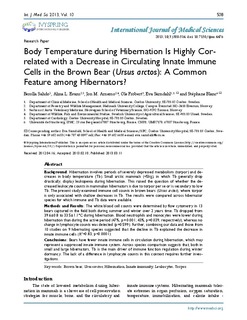Body Temperature during Hibernation Is Highly Correlated with a Decrease in Circulating Innate Immune Cells in the Brown Bear (Ursus arctos): A Common Feature among Hibernators?
Original version
Sahdo, B., Evans, A., Arnemo, J. M., Fröbert, O., Särndahl, E., & Blanc, S. (2013). Body Temperature during Hibernation Is Highly Correlated with a Decrease in Circulating Innate Immune Cells in the Brown Bear (Ursus arctos): A Common Feature among Hibernators? International Journal of Medical Sciences, 10(5), 508-514. doi: http://dx.doi.org10.7150/ijms.4476 10.7150/ijms.4476Abstract
Background: Hibernation involves periods of severely depressed metabolism (torpor) and decreases
in body temperature (Tb). Small arctic mammals (<5kg), in which Tb generally drop
drastically, display leukopenia during hibernation. This raised the question of whether the decreased
leukocyte counts in mammalian hibernators is due to torpor per se or is secondary to low
Tb. The present study examined immune cell counts in brown bears (Ursus arctos), where torpor
is only associated with shallow decreases in Tb. The results were compared across hibernator
species for which immune and Tb data were available.
Methods and Results: The white blood cell counts were determined by flow cytometry in 13
bears captured in the field both during summer and winter over 2 years time. Tb dropped from
39.6±0.8 to 33.5±1.1°C during hibernation. Blood neutrophils and monocytes were lower during
hibernation than during the active period (47%, p= 0.001; 43%, p=0.039, respectively), whereas no
change in lymphocyte counts was detected (p=0.599). Further, combining our data and those from
10 studies on 9 hibernating species suggested that the decline in Tb explained the decrease in
innate immune cells (R2=0.83, p<0.0001).
Conclusions: Bears have fewer innate immune cells in circulation during hibernation, which may
represent a suppressed innate immune system. Across species comparison suggests that, both in
small and large hibernators, Tb is the main driver of immune function regulation during winter
dormancy. The lack of a difference in lymphocyte counts in this context requires further investigations.
